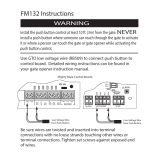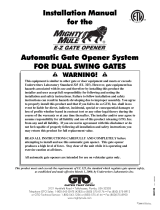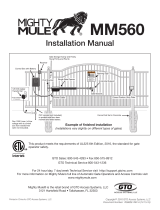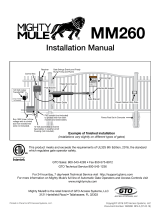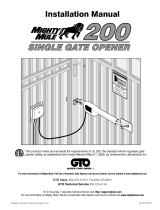
8
GTO/PRO 2000 Series Swing Gate Operators
These Specifications are subject to change without notice.
Technical Specifications
DRIVE
• Low friction screw drive (linear actuator).
• Temperature rating of motor -30 ºF (-34 ºC) to +160 ºF (71ºC).
• Powered by a 12 Vdc motor; generates 650 ft. lb. of torque at 12 V.
• 110
o
degree opening time approximately 15 to 20 s.
• Maximum push-pull tube stroke 24”.
•
Operator length with push-pull tube fully retracted is 37
3
/
4
” (95.8 cm), mounting point to mounting point.
• Limit switches are internal.
POWER
• System is powered by a 12 Vdc, 7.0 Ah, sealed, rechargeable battery.
• Battery charge maintained by 120 Vac, 60 Hz input and 18 Vac at 40 VA (2.9 A) output; transformer
rectified to 14.5 Vdc through the GTO Control Board. Control board fuses (2) are rated for 15 A.
NOTE: DO NOT connect transformer directly to any battery. Do not replace fuses with higher
ampere rated fuses; doing so will void your warranty and may damage your control board.
• Battery charge maintained by GTO Solar Panel Charger: float voltage 14.5 Vdc output from
19
3
/
8
" x 15
1
/
4
" silicon alloy panel; generates minimum of 10 W at 600 mA. Gated diode on control
board prevents battery discharge.
CONTROL
• GTO microprocessor-based control board is set for single leaf, pull-to-open gate installations. DIP
switches can be adjusted to accommodate an optional kit for push-to-open gates (see Accessory
Catalog).
• Control board has temperature compensated circuits.
•A circuit on the control board regulates charging. "Sleep draw" is 40 mA; "active draw" is 2 to 5 A.
• Auto-memorization of digital transmitter code.
• GTO remote-mounted RF receiver tuned to 318 MHz.
• adjustable auto-close timer (OFF to 120 s), inertia, and obstruction sensitivity using three (3)
potentiometers.
• Power terminal bock accommodates a transformer and solar panels.
• DIP switches simplify setup of gate operator.
• Accessory terminal block fully compatible with push button controls, digital keypads, safety loops, card
readers, etc.
• Control board allows connection of safety edge sensors and photoelectric sensors.
• Audio entrapment alarm sounds if unit encounters an obstruction twice while opening or closing.
OPERATIONAL CAPACITY
• The GTO/PRO 2000 series will move gates weighing up to 1000 lb. (453 kg) and up to 20 ft. (6.1 m)
in length provided all installation procedures have been followed. Ball bearing hinges should be
used on all gates weighing over 250 lb. (113.4 kg).
• The GTO/PRO 2000 series operators are capable high volume cycling; however, the total cycles per day
will depend on the motor current and efficiency of the gate installation. For questions about specific appli-
cations and information regarding cycling duty when charged by solar panels, call the GTO service
department at (800) 543-1236 or (850) 575-4144.
Gate Weight
Gate Length
Gate Capacity Chart
(estimated number of cycles based on use with a transformer)
1000 lb.
800 lb.
600 lb.
400 lb.
200 lb.
160
170
180
190
200
6-8 ft.
150
160
170
180
190
10 ft.
140
150
160
170
180
12 ft.
130
140
150
160
170
14 ft.
120
130
140
150
160
16 ft.
110
120
130
140
150
18 ft.
100
110
120
130
140
20 ft.





















